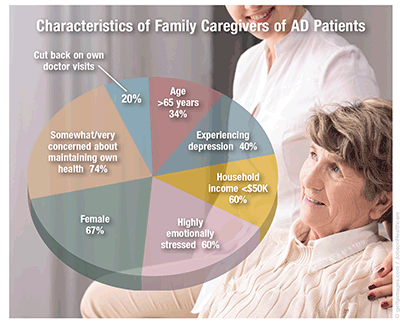US Pharm. 2017;42(1):28.
Alzheimer’s disease (AD) causes nerve cells in the brain to gradually die, affecting a person’s memory and thinking ability. More than 5.2 million Americans aged 65 years and older have AD. According to the National Institutes of Health, in 2015, nearly 16 million family members and friends provided 18 billion hours of unpaid care to persons with AD, at an estimated cost of $221 billion.

Caregiver Characteristics: A primary caregiver may be a spouse, parent, child, grandchild, or friend. In the United States, 65% of caregivers to adults are female, 6% are spouses, 15% have been caregiving for 10 years or more, 23% live with the care recipient, and 53% are the primary caregiver. Many caregivers who work and provide care experience conflicting demands from these responsibilities. In 2000, of 22 million family caregivers (of whom 15 million were caregivers for AD), baby boomers made up 40%, and 19% were providing care for both a parent and a child. The average caregiver is a 46-year-old woman who works outside the home while spending 18 hours each week caring for her mother, according to a study.
Caregiver Health Consequences: Caring for an AD relative full-time is challenging. Primary caregivers often ignore their own needs to focus on their AD relatives. Nearly all caregivers experience some sort of impact on their health. Almost one-half of all caregivers are older than 50 years, making them more vulnerable to a decline in their own health, and 74% are concerned about their own health. Effects on AD caregivers include sleep deprivation (77%), less exercise (69%), gaining or losing weight (66%), strains or aches (63%), high stress/anxiety (60%), poor eating habits (56%), depression (40%), and putting off their own medical care (20%).
Support Services: In 2010, 700,000 caregivers received services through the National Family Caregiver Support Program. These services helped them manage their caregiving responsibilities while keeping their loved ones at home as long as possible. Programs included access-assistance services, counseling and training for coping with caregiving stresses, and respite services for temporary relief from caregiving responsibilities. Administration on Aging data showed that these services helped family caregivers keep their loved ones at home. Nearly 40% of caregivers provided care for 2 to 5 years, 29% gave care for 5 to 10 years, 77% said that these services enabled them to provide care longer than otherwise possible, and 89% reported that the services helped them be a better caregiver. Nearly one-half of caregivers of nursing home–eligible patients stated that the patient could not have remained at home without support services.
To comment on this article, contact rdavidson@uspharmacist.com.






